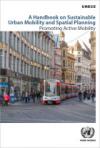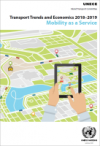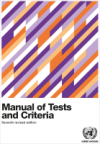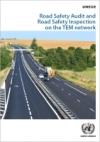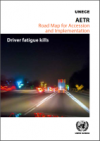Publications
Displaying Results 41 - 60 of 209
- Pусский
В 2002 году государства-члены Европейского региона ЕЭК и ВОЗ разработали Общеевропейскую программу по транспорту, окружающей среде и охране здоровья (ОПТОСОЗ). ОПТОСОЗ обеспечивает межсекторальные и межправительственные политические механизмы, что способствует развитию мобильности и транспортных стратегий, которые учитывают проблемы окружающей среды и здоровья. За все эти годы в рамках ОПТОСОЗ
- English
Member States in the ECE and WHO European Region established the Transport,Health and Environment Pan European Programme (THE PEP) in 2002. By providing an intersectoral and intergovernmental policy framework, THE PEP promotes mobility and transport strategies that integrate environmental and health concerns. Over the years, THE PEP has led to the development of implementation mechanisms to
- English
This study, commissioned by the Steering Committee of the Transport, Health and Environment PanEuropean Programme (THE PEP) through its Partnership on Jobs in Green and Healthy Transport, examines the economy-wide employment implications of an accelerated shift towards greener land
- English
ECE/TRANS/290,
Sales No. E.20.VIII.2,
ISBN 978-92-1-117241-6,
Price: US$ 35,
Languages: E, F, R
The Agreement on the International Carriage of Perishable Foodstuffs and on the Special Equipment to be Used for such Carriage (ATP) was done at Geneva on 1 September 1970 and entered into force on 21 November 1976.
The objectives of the ATP are to facilitate international transport
- English
Mobility as a Service (MaaS) is a new mobility concept gaining pace in many cities around the world. Its value proposition concerns integration of mobility services which is realized by providing trip planning and one-stop fare purchase for the user through a single platform.Since MaaS is only emerging, the analysis of real-life demonstrations is still limited and, thus, evidence on the
- English
Regional maps available here
Extreme weather events, some of which are increasing in intensity and frequency, as well as slower onset climate changes (for example, sea level rise) and cumulative effects can result in transportation infrastructure damages, operational disruptions, and
- English
ST/SG/AC.10/11/Rev.7
Sales No. E.20.VIII.1
ISBN 978-92-1-130394-0
eISBN 978-92-1-004503-2
Languages: E, F, (A, C, R, S forthcoming)
How to order this publication?
This publication is also available online for free (download).
The "Manual of Tests and Criteria" contains criteria, test methods and
- English
These recommendations have been developed in the light of technical progress, the advent of new substances and materials, the exigencies of modern transport systems and, above all, the requirement to ensure the safety of people, property and the environment. They are addressed to governments and international organisations concerned with the regulation of the transport of dangerous goods. The
- English
The GHS addresses classification of chemicals by types of hazard and proposes harmonized hazard communication elements, including labels and safety data sheets. It aims at ensuring that information on physical hazards and toxicity from chemicals be available in order to enhance the protection of human health and the environment during the handling, transport and use of these chemicals.
The GHS
- English
The European Agreement concerning the International Carriage of Dangerous Goods by Inland Waterways (ADN) done at Geneva on 26 May 2000 under the auspices of the United Nations Economic Commission for Europe (UNECE) and the Central Commission for Navigation on the Rhine (CCNR) has been in force since February 2008. The Agreement currently has eighteen Contracting Parties. The Regulations
- English
Adopted on 30 September 1957 in Geneva under the auspices of the United Nations Economic Commission for Europe (UNECE), the ADR entered into force on 29 January 1968. This authoritative Agreement is intended to increase the safety of international transport of dangerous goods by road. Its Annexes A and B contain the technical requirements for road transport, i.e. the conditions under
- English
During recent decades governments all around the world were faced with a complicated set of options for investing in transport, including transport infrastructure. This publication examines main principles for determining the most appropriate models for financing transport infrastructure expenditures but also illustrates and analyses many innovative ways to finance transport infrastructure.
- English
Brochure on Trans-European Motorways (TEM) ProjectThis brochure gives an overview of the TEM project, its objectives, organization and how to join it.
- English
Road Safety Audit (RSA) and Road Safety Inspection (RSI) are road infrastructure safety management measures which are considered as important engineering tools for improving infrastructure safety. Road safety is frequently discussed at the TEM Steering Committee, which commissioned Road Safety Audit and Road Safety Inspection on the TEM Network report.The
- English
TEM Project Strategic Plan 2017 – 2021 is a roadmap for the implementation of the TEM Project for 2017 – 2021.The Strategic Plan 2017 – 2021 value proposition:The TEM Project aims to support UNECE and the Inland Transport Committee in pursuing the Sustainable Development Goals related to road infrastructure management;TEM Project will interpret and translate the Sustainable Development Goals
- English
Phase 1 of the Highspeed Masterplan for the TER region has now been completed. The study is available here and covers the following areas:- An introduction to, and history of, High Speed Railways- A review of the benefit, political background, best practice and status of high-speed- Review of related work,
- English
ECE/TRANS/271, Sales No. E.17.VIII.2,ISBN 978-92-1-139160-2, Price: US$ 35, Languages: E, F, RThe Agreement on the International Carriage of Perishable Foodstuffs and on the Special Equipment to be Used for such Carriage (ATP) was done at Geneva on 1 September 1970 and entered into force on 21 November 1976. The objectives of
- English
The GHS addresses classification of chemicals by types of hazard and proposes harmonized hazard communication elements, including labels and safety data sheets. It aims at ensuring that information on physical hazards and toxicity from chemicals be available in order to enhance the protection of human health and the environment during the handling, transport and use of these chemicals.The GHS
- English
These recommendations have been developed in the light of technical progress, the advent of new substances and materials, the exigencies of modern transport systems and, above all, the requirement to ensure the safety of people, property and the environment. They are addressed to governments and international organisations concerned with the regulation of the transport of dangerous goods. The
- English
European Agreement concerning the Work of Crews of Vehicles Engaged in International Road Transport (AETR)Road Map for Accession and ImplementationErratum: on page 25, the Russian Federation is erroneously listed as one of the countries applying the AETR Agreement domestically. The authors regret this error.


